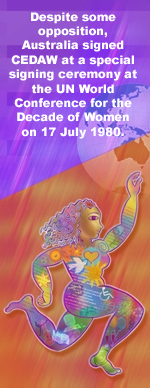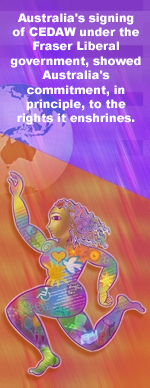Woman of the World - Australia's signing of Cedaw
Woman of the World -
Know Your International Human Rights
- Preface
- What are human rights?
- What is the United Nations?
- The UN: Protecting the rights of woman
- What is CEDAW
- Australia's signing of CEDAW
- A guide to the rights in CEDAW
- CEDAW and the Sex Discrimination Act
- The Optional Protocol to CEDAW
- What about Beijing?
- What can you do: The public sphere
- What can you do: Private actions

The decision by Australia to sign and later ratify CEDAW was a long process, surrounded by much debate.
Some comments and assertions about CEDAW:
'The convention [CEDAW]... seeks to assert that many women who consider themselves to be both happy and equal in their roles as mothers and wives are not happy... the convention in effect belittles the vital role of these women and consequently the role of their husbands'.
Senator Crichton-Browne, Australian Senate, 9 December 1983.
'From where did the clamour for equality originate? It began in the Eastern Soviet bloc countries, which, while speaking loudly for equality, were not particularly renowned for their practice of human rights. I am sure that Australian women do not want the same rights as women in Iran and India.'
Senator Boswell, Australian Senate, 29 November 1983.
Opposition to CEDAW: Many Australians feared CEDAW and the effect that it would have on Australian society. Some groups and individuals organised rallies and wrote letters to members of parliament, hoping to influence Australia not to sign. Several parliamentarians went on to voice their opposition to CEDAW in parliament and worked to prevent Australia from signing the Convention.
Opponents argued that CEDAW would force women out of their homes and into the workforce and cause a breakdown of family life. In addition, the fact that the former Soviet Union bloc participated in the UN led some people to believe that Australia signing CEDAW would give these countries the power to make laws for Australia.
Support for CEDAW:
There was strong support for CEDAW from many Australian women's organisations. This support was demonstrated at a national level and also in local branches. These groups included the Federation of Business and Professional Women, the Young Women's Christian Association and Zonta International. Many other NGOs also supported the Convention through the National Council of Women, a voluntary co-ordinating body that at the time had 583 affiliated organisations, representing over 1 million members.
 Supporters worked to secure political support for CEDAW. For example, the Women's Electoral Lobby sent letters and had meetings, asking politicians and political candidates to support the Convention. Seminars were held and pamphlets were distributed to publicise CEDAW and inform women, allowing them to see how the Convention could address many issues relevant to their lives.
Supporters worked to secure political support for CEDAW. For example, the Women's Electoral Lobby sent letters and had meetings, asking politicians and political candidates to support the Convention. Seminars were held and pamphlets were distributed to publicise CEDAW and inform women, allowing them to see how the Convention could address many issues relevant to their lives.
The signing of CEDAW:
Despite some opposition, Australia signed CEDAW at a special signing ceremony at the UN World Conference for the Decade of Women on 17 July 1980. Australia was one of the 23 countries that helped prepare the ceremony and sent a strong delegation of experts led by The Hon Robert Ellicot (the then Minister for Home Affairs).
Australia's signing of CEDAW, under the Fraser Liberal government, showed Australia's commitment, in principle, to the rights it enshrines. After signing, the Hon Robert Ellicott and the Hon Andrew Peacock (the then Minister for Foreign Affairs) said that the signing evidenced 'Australia's policy of equality for women and the elimination of discrimination.'

